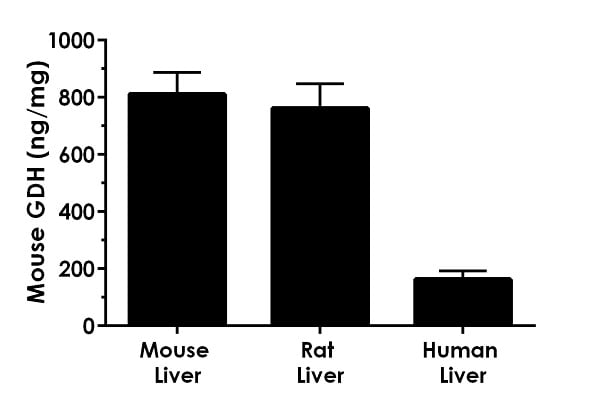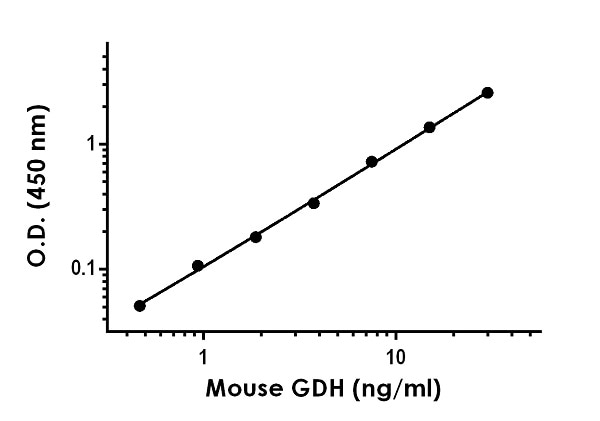Mouse GDH ELISA Kit (ab246532)
Key features and details
- One-wash 90 minute protocol
- Sensitivity: 60 pg/ml
- Range: 0.3125 ng/ml - 30 ng/ml
- Sample type: Cell culture extracts, Cit plasma, Hep Plasma, Serum, Tissue Extracts
- Detection method: Colorimetric
- Assay type: Sandwich (quantitative)
- Reacts with: Mouse
Overview
-
Product name
Mouse GDH ELISA Kit
See all H6PD/GDH kits -
Detection method
Colorimetric -
Precision
Intra-assay Sample n Mean SD CV% Extract 8 3.8% Inter-assay Sample n Mean SD CV% Extract 3 3.3% -
Sample type
Serum, Cell culture extracts, Tissue Extracts, Hep Plasma, Cit plasma -
Assay type
Sandwich (quantitative) -
Sensitivity
60 pg/ml -
Range
0.313 ng/ml - 30 ng/ml -
Recovery
Sample specific recovery Sample type Average % Range Serum 116 108% - 128% Cell culture extracts 94 90% - 98% Tissue Extracts 107 102% - 112% Hep Plasma 98 92% - 102% Cit plasma 89 87% - 93% -
Assay time
1h 30m -
Assay duration
One step assay -
Species reactivity
Reacts with: Mouse -
Product overview
Mouse GDH ELISA Kit (ab246532) is a single-wash 90 min sandwich ELISA designed for the quantitative measurement of GDH protein in cit plasma, hep plasma, serum, tissue extracts, and cell culture extracts. It uses our proprietary SimpleStep ELISA® technology. Quantitate Mouse GDH with 60 pg/ml sensitivity.
SimpleStep ELISA® technology employs capture antibodies conjugated to an affinity tag that is recognized by the monoclonal antibody used to coat our SimpleStep ELISA® plates. This approach to sandwich ELISA allows the formation of the antibody-analyte sandwich complex in a single step, significantly reducing assay time. See the SimpleStep ELISA® protocol summary in the image section for further details. Our SimpleStep ELISA® technology provides several benefits:
- Single-wash protocol reduces assay time to 90 minutes or less
- High sensitivity, specificity and reproducibility from superior antibodies
- Fully validated in biological samples
- 96-wells plate breakable into 12 x 8 wells stripsA 384-well SimpleStep ELISA® microplate (ab203359) is available to use as an alternative to the 96-well microplate provided with SimpleStep ELISA® kits.
-
Notes
Abcam has not and does not intend to apply for the REACH Authorisation of customers’ uses of products that contain European Authorisation list (Annex XIV) substances.
It is the responsibility of our customers to check the necessity of application of REACH Authorisation, and any other relevant authorisations, for their intended uses. -
Platform
Pre-coated microplate (12 x 8 well strips)
Properties
-
Storage instructions
Store at +4°C. Please refer to protocols. -
Components 1 x 96 tests 10X Mouse GDH Capture Antibody 1 x 600µl 10X Mouse GDH Detector Antibody 1 x 600µl 10X Wash Buffer PT (ab206977) 1 x 20ml 50X Cell Extraction Enhancer Solution (ab193971) 1 x 1ml 5X Cell Extraction Buffer PTR (ab193970) 1 x 10ml Antibody Diluent CPR 1 x 6ml Mouse GDH Lyophilized Recombinant Protein 2 vials Plate Seals 1 unit Sample Diluent NS (ab193972) 1 x 12ml SimpleStep Pre-Coated 96-Well Microplate (ab206978) 1 unit Stop Solution 1 x 12ml TMB Development Solution 1 x 12ml -
Research areas
-
Function
Oxidizes glucose-6-phosphate and glucose, as well as other hexose-6-phosphates. -
Tissue specificity
Present in most tissues examined, strongest in liver. -
Involvement in disease
Defects in H6PD are a cause of cortisone reductase deficiency (CRD) [MIM:604931]. In CRD, activation of cortisone to cortisol does not occur, resulting in adrenocorticotropin-mediated androgen excess and a phenotype resembling polycystic ovary syndrome (PCOS). -
Sequence similarities
In the N-terminal section; belongs to the glucose-6-phosphate dehydrogenase family.
In the C-terminal section; belongs to the glucosamine/galactosamine-6-phosphate isomerase family. 6-phosphogluconolactonase subfamily. -
Cellular localization
Endoplasmic reticulum lumen. Microsomes, endoplasmic reticulum lumen. - Information by UniProt
-
Alternative names
- 6 phosphogluconolactonase
- 6-phosphogluconolactonase
- 6PGL
see all -
Database links
- Entrez Gene: 100198 Mouse
- Entrez Gene: 66171 Mouse
- SwissProt: Q8CFX1 Mouse
- SwissProt: Q9CQ60 Mouse
- Unigene: 22183 Mouse
- Unigene: 282284 Mouse
- Unigene: 402679 Mouse
Images
-
SimpleStep ELISA technology allows the formation of the antibody-antigen complex in one single step, reducing assay time to 90 minutes. Add samples or standards and antibody mix to wells all at once, incubate, wash, and add your final substrate. See protocol for a detailed step-by-step guide.
-
The GDH standard curve was prepared as described in Section 10. Raw data values are shown in the table. Background-subtracted data values (mean +/- SD) are graphed.
-
The GDH standard curve was prepared as described in Section 10. Raw data values are shown in the table. Background-subtracted data values (mean +/- SD) are graphed.
-
Interpolated concentrations of native GDH in mouse NIH/3T3 cell extract based on a 250 μg/mL extract load, mouse liver tissue extract based on a 20 μg/mL extract load, and mouse brain tissue extract based on a 50 μg/mL extract load. The concentrations of GDH were measured in duplicate and interpolated from the GDH standard curve and corrected for sample dilution. The interpolated dilution factor corrected values are plotted (mean +/- SD, n=2). The mean GDH concentration was determined to be 1.940 ng/mL in NIH/3T3 cell extract, 8.822 ng/mL in liver tissue extract, and 5.428 ng/mL in brain tissue extract.
-
 Other species reactivity was determined by measuring liver tissue extract samples of various species.
Other species reactivity was determined by measuring liver tissue extract samples of various species.Other species reactivity was determined by measuring liver tissue extract samples of various species, interpolating the protein concentrations from the mouse standard curve, and expressing the interpolated concentrations in ng of GDH protein per mg of extract. The mean GDH concentration was determined to be 811.1 ng/mg in mouse liver extract, 762.4 ng/mg in rat liver extract, and 163.0 ng/mg in human liver extract.
-
To learn more about the advantages of recombinant antibodies see here.

















